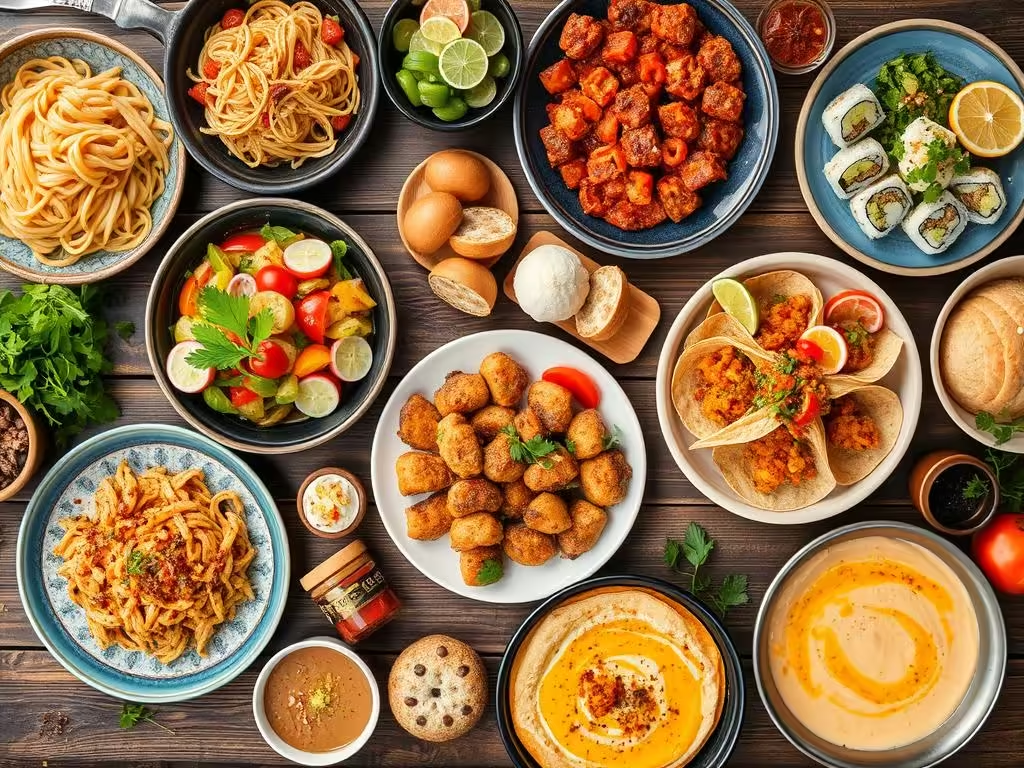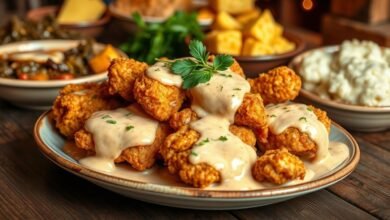
Imagine a world where you can explore the most exquisite flavors from every corner of the globe. A world where food brings together diverse cultures, sharing a common language. Welcome to the amazing world of the best cuisine. Here, you’re starting a unique food adventure.
In the United States, you’ll find a mix of foods from many cultures. You can enjoy pizza from Italy, fries from Belgium or the Netherlands, and hamburgers and frankfurters from Germany. This shows how American food is a mix of global flavors.
This is just the start of your food journey. Let’s explore the vibrant tastes and cultural traditions of the world’s top cuisines. You’ll find everything from Mexican food’s variety and nutrition to Thai dishes full of herbs and spices. There’s also the Greek love for olive oil, Indian spices, and the Japanese art of cooking.
Key Takeaways
- Discover the diverse culinary traditions that shape the world’s best cuisine
- Explore the iconic regional dishes and flavors that define global food culture
- Embark on a culinary journey that showcases the interconnectedness of international flavors
- Savor the authentic taste of renowned national cuisines and their impact on global dining
- Uncover the fascinating history and cultural influences that have molded the world’s top cuisines
Unleashing the Flavors of Mexican Cuisine
Mexican cuisine is full of rich, authentic flavors that have won over food lovers all over the world. It combines ancient sauces with the vibrant mix of pre and post-Colombian cooking. This makes for a unique taste experience.
Mole: Ancient Sauce of Chili Peppers and Chocolate
The mole is at the core of Mexican food. It’s an ancient sauce made from chili peppers, spices, and chocolate. This mix creates a taste that is both exciting and memorable.
This dish shows off Mexico’s wide variety of ingredients and the creativity of its cooks.
Tacos al Pastor: A Fusion of Pre and Post-Colombian Traditions
Tacos al pastor is another great example of Mexican cuisine’s mix of flavors. It combines Spanish spit-roasted pork with traditional Mexican tastes. This creates a unique taste that has become a favorite in Mexico.
This dish shows the richness and diversity of Mexican food, making it one of the world’s top cuisines.
“Mexican cuisine is a symphony of flavors, weaving together the ancient and the modern, the indigenous and the introduced, into a captivating culinary tapestry that is truly without equal.”
Exploring Mexican flavors reveals a world full of culinary wonders. From the complex mole to the lively tacos al pastor, Mexican food proves its power to win over food lovers everywhere.
Exploring the Vibrant Tastes of Thai Cuisine
Thai food is famous for its bold flavors and bright colors. This has made Thai restaurants more popular around the world. A study in Atlanta found a 20% increase in people who love Thai food and visit Thai restaurants more often.
This rise in popularity comes from the mix of sweet, sour, salty, and spicy tastes in Thai food. These tastes are key to Thai cooking.
Thai chefs focus on balance and harmony in their cooking. They use ingredients like lemongrass, galangal, kaffir lime leaves, and chili peppers. This has led to a 15% increase in demand for lemongrass dishes in high-end Thai restaurants.
Tom Yam Kung: A Rave Party for the Taste Buds
Tom Yam Kung is a spicy and sour shrimp soup that shows off Thai flavors. It has lemongrass, kaffir lime leaves, and galangal, with chili peppers adding heat. This soup is a hit because of its perfect mix of flavors.
Massaman Curry: A Thai Curry with Islamic Roots
Massaman Curry is a curry with roots in Islamic cooking. It blends Middle Eastern spices with Thai flavors. This curry is a treat for the senses with its complex taste.
Thai food is loved worldwide for its bold flavors and diverse influences. From the famous Tom Yam Kung to the unique Massaman Curry, it offers a delicious journey for food lovers.

The Mediterranean Allure of Greek Cuisine
Greek cuisine is a journey into the Mediterranean lifestyle. It focuses on fresh, high-quality ingredients. Every dish, from Greek salads to Greek pastries, reflects the country’s rich history and culture.
Greek olive oil, called “liquid gold,” is key to Greek cooking. It’s known for its amazing quality and taste. This oil is vital in many dishes and is good for your heart and health.
The Mediterranean diet, which includes Greek cuisine, focuses on plants like Greek yogurt and legumes. It also has lots of fresh fruits and vegetables. These foods are full of nutrients and help you stay healthy.
Greek hospitality makes dining in Greece special. It’s not just about eating; it’s about enjoying the moment and the company. It’s a way to dive into the Greek culture that has won the world’s heart for centuries.
“Greek cuisine is a symphony of flavors, where the land, sea, and sun converge to create a culinary masterpiece that nourishes both the body and the soul.”

Spice Odyssey: Discovering Indian Culinary Treasures
Start a thrilling journey through Indian cuisine’s vibrant flavors. Spices will dance on your tongue and traditions become art. From simple lentil-based dal to the versatile dosa, Indian food treasures are waiting for you.
Dal: Lentils Elevated to an Art Form
The humble lentil turns into a flavor symphony with skilled Indian chefs. Dal, a key dish in Indian homes, highlights the country’s vegetarian skills. With many regional versions, each dal dish shows off spices, herbs, and techniques that turn simple legumes into masterpieces.

Dal Makhani from North India is creamy and comforting, while Sambar from the South is tangy and aromatic. Each dal dish shares a piece of India’s rich food history. This dish proves Indian cooks’ creativity and skill in making simple ingredients into delicious meals.
Dosa: A Versatile Pancake for All Occasions
Dosa, a crispy Indian pancake, changes with every occasion. From the South, it shows Indian cuisine’s diversity and creativity. Made from fermented rice and lentils, dosas can be filled with many things, from spiced potatoes to chutneys, pleasing everyone.
- Masala Dosa: A classic filled with a spiced potato mixture
- Rava Dosa: A crispy variation made with semolina
- Mysore Masala Dosa: A flavorful combination of spicy and tangy fillings
- Paper Dosa: A paper-thin, large and crispy dosa
The dosa‘s versatility shows Indian cooks’ creativity. It’s loved for breakfast, lunch, or dinner, bringing people together with its rich flavors.
Mastering the Art of Japanese Gastronomy
Japanese cuisine is famous for its precision and focus on details. From the strict rules of sushi masters to the detailed plating of kaiseki meals, it stands out. The country values fresh, high-quality ingredients and perfects culinary techniques. This has made Japanese food famous worldwide.
Sushi and Sashimi: Raw Perfection
Sushi and sashimi are at the core of Japanese food. Shokunin, the sushi chefs, spend their lives learning how to make these dishes. They pick the freshest seafood and shape the rice with great care. This creates a dining experience like no other.
Sashimi is a dish of thinly sliced raw fish. It shows Japan’s respect for the sea’s natural tastes. The dashi, a rich broth, is key to Japanese food. It brings out the flavors in many dishes.
Tempura: The Pinnacle of Deep-Frying
Tempura is a deep-fried dish that’s a highlight of Japanese food. It has a light batter and uses seasonal ingredients like prawns and vegetables. This makes a perfect mix of textures and tastes.
The shun practice means using ingredients in season. This makes each tempura dish fresh and full of flavor.
Japanese food is not just about the kitchen. It’s also about how the food looks and how it’s served. Chefs are seen as shokunin, or artisans. The way food is served adds to the dining experience, making it special.
Japanese food and hospitality offer a unique dining experience. Every step, from preparing the food to serving it, is designed to delight. Japanese gastronomy shows the country’s dedication to quality, innovation, and perfection.
Savoring the Passion of Spanish Cuisine
Spain’s culinary heritage is a mix of ancient traditions, diverse cultures, and a love for quality ingredients. The tapas culture and the art of making Jamon Iberico show Spain’s love for good food and hospitality.
Food is a big deal in Spain, with meals often going late into the night. People enjoy sharing tapas like patatas bravas and gambas al ajillo with friends and family. This shows the importance of sharing meals in Spanish culture.
Jamon Iberico: The Ritual of Cured Ham
The Jamon Iberico is a key part of Spanish cuisine. It’s a cured ham that shows Spain’s dedication to quality. The curing and carving of this ham is a ritual that highlights Spain’s culinary traditions.
This ham comes from the Iberian black pig, found only in the Iberian Peninsula. These pigs eat acorns and herbs in the wild, giving the ham a unique taste. Curing the ham takes years, making sure it gets just the right balance of flavors.
When Jamon Iberico is carved, it’s a big deal. Thin slices show off the meat’s fat and lean parts. This tradition, passed down through generations, celebrates Spanish cuisine and the love for cured meats.
“In Spain, food is not just sustenance – it is a way of life, a celebration of the senses, and a testament to the country’s rich cultural heritage.”
The Epicurean Delights of French Gastronomy
France’s French cuisine and food culture have won the hearts of food lovers around the world. From the flaky macaron to the classic French baguette, France shows the beauty of precision and passion in culinary tradition.
Macarons: Unicorn Food from Parisian Patisseries
The simple macaron has turned into a big deal in French pastries. These small, colorful treats are made with meringue and filled with cream. Now, they’re all over social media, making everyone jealous.
Parisian patisseries have made the macaron an art. They offer many flavors and colors that delight everyone.
Baguette: The Quintessential French Delight
Talking about French breads means mentioning the baguette. This long, thin loaf is famous for its golden crust and soft inside. It’s a symbol of French culinary tradition.
Enjoy it alone or in a French bistro sandwich, the baguette shows French precision and French hospitality.
Whether you’re in a cozy French bistro or a fancy French Michelin-starred restaurant, French food is all about respect and detail. From the macaron to the baguette, it shows the lasting impact of French cuisine.
“The only thing that you cannot replace in a great meal is the sharing of it with other people.”
| French Culinary Regions | Specialty Dishes |
|---|---|
| Auvergne-Rhône-Alpes | Coq au Vin |
| Bourgogne-Franche-Comté | Burgundy Wines |
| Brittany | Breton Crêpes |
| Centre-Val de Loire | Tarte Tatin |
| Corsica | Fiadone, Brocciu Cheese |
| Grand Est | Choucroute Garnie |
| Hauts-de-France | Carbonnade Flamande |
| Normandy | Moules Marinières |
| Nouvelle Aquitaine | Foie Gras |
| Occitanie | Cassoulet |
| Pays de la Loire | Rillettes de Porc |
Embracing the Culinary Diversity of best cuisine in the world
The world’s best cuisine is a mix of diverse global cuisines. Each has its own flavors, ingredients, and cultural importance. From Mexico’s ancient sauces to India’s spice odyssey, the world’s food shows the richness of human culture.
Exploring this culinary diversity lets food lovers learn and enjoy the world’s iconic national dishes and international flavors. By diving into global food culture, travelers connect more with the best cuisine in the world and the people who make it.
From street food stalls in Bangkok to Michelin-starred restaurants in Paris, food tourism offers many culinary experiences. Now, with a focus on sustainable travel, food trips help support local areas and lessen our environmental impact.
“Food serves as a medium for social and cultural exchange, with unique dishes reflecting individual histories and experiences such as travel and regional cooking styles.”
By celebrating the world’s best cuisine, we enjoy different cultures and learn about the global food culture. Whether it’s learning about a Mexican mole or an Indian curry, exploring food takes us on a journey of cultural exchange and appreciation.
Conclusion
In this journey, we’ve looked at the world’s top best cuisine in the world. Each has its own special flavors, traditions, and cultural importance. We’ve seen the rich mole of Mexico and the perfect mix of Thai cuisine. also explored the Mediterranean allure of Greek cuisine, the spice journey of Indian cuisine, and the art of Japanese gastronomy.
We’ve also dived into the passionate food culture of Spanish cuisine and the epicurean delights of French gastronomy. The global food culture is a mix of many culinary traditions.
By trying different foods, food lovers can learn more about the world’s iconic dishes and authentic flavors. This journey has opened our minds and hearts to the global food culture. It encourages us to explore more through food tourism and celebrate the diversity of the world’s cuisines.
As we end this food adventure, let’s keep enjoying new tastes, cultures, and traditions. Let the world’s diverse cuisines keep inspiring and delighting us, one bite at a time.
FAQ
What are some of the popular TV shows that showcase global cuisine?
Popular TV shows like Europe From Above, Taste the Nation with Padma Lakshmi, Conan Without Borders, and James May: Our Man in Japan highlight global cuisine. Other shows include Gordon’s Great Escape, High on the Hog, Eater’s Guide to the World, Fresh, Fried, and Crispy, Cooked, and Midnight Asia.
What is mole, a traditional Mexican sauce?
Mole is a traditional Mexican sauce. It’s made from chili peppers, spices, and chocolate. This mix creates a rich, complex flavor.
What is tacos al pastor, a popular Mexican dish?
Tacos al pastor combines pre-Colombian and post-Colombian flavors. It features spit-roasted pork with traditional Mexican ingredients.
What are the key characteristics of Thai cuisine?
Thai cuisine is known for its complex flavors. It combines spicy, sour, salty, sweet, and umami tastes.
What is Tom Yam Kung, a popular Thai soup?
Tom Yam Kung is a Thai soup. It has lemongrass, galangal, kaffir lime leaves, and chili peppers. These ingredients create a flavorful dish.
What is Massaman curry, a Thai curry with Islamic roots?
Massaman curry is a Thai curry with Islamic roots. It shows the blend of cultures in Thai cuisine.
What are the key characteristics of Greek cuisine?
Greek cuisine celebrates the Mediterranean lifestyle. It focuses on fresh ingredients like olive oil, feta cheese, and kalamata olives.
What are the key characteristics of Indian cuisine?
Indian cuisine is a spice odyssey. It uses herbs and spices to create complex, flavorful dishes.
What is dal, a humble Indian dish of lentils?
Dal is a dish of lentils. It’s elevated to an art form, showing the versatility and richness of Indian vegetarian cooking.
What is dosa, a savory Indian pancake?
Dosa is a savory Indian pancake. It can be filled with various ingredients. This shows the diverse culinary traditions of the subcontinent.
What are the key characteristics of Japanese cuisine?
Japanese cuisine is known for its precision and detail. From sushi masters to intricate kaiseki meals, it’s all about quality.
What are sushi and sashimi, and how do they showcase Japanese culinary traditions?
Sushi and sashimi highlight Japan’s love for fresh ingredients. Tempura is another dish, known for its light, crispy batter.
What are the key characteristics of Spanish cuisine?
Spanish cuisine is all about passion and hedonism. It’s a culture that values food, from tapas to late-night dinners.
What is Jamon Iberico, a famous Spanish ham?
Jamon Iberico is a famous Spanish ham. Its curing and carving show Spain’s love for quality ingredients and sharing meals with others.
What are the key characteristics of French cuisine?
French cuisine values precision and passion. It’s a culture that emphasizes the art of dining. From macarons to baguettes, French food is celebrated worldwide.
What are some of the iconic French culinary delights?
French food is known for its attention to detail. From bistro dishes to Michelin-starred meals, it’s all about quality. The flaky macaron and the classic baguette are perfect examples.
Source Links
- 10 best cuisines in the world | CNN
- LET’S EAT THE WORLD – Culinary Experiences from the creators of Cook’n With Class – Culinary holidays, workshops, & online cooking for food, wine, & travel lovers
- Exploring Global Cuisine: A Culinary Journey Around the World
- Why Did It Take a White Chef to Pique My Interest in My Own Mexican Culture?
- Catering with Authentic Mexican Cuisine | Chapala’s Mexican Restaurant
- Exploring the Delights of Thai Cuisine: A Culinary Journey – Colonial Kitchen & Bar
- Spice Up Your Palate: Exploring the Bold Flavors of Thai Cuisine
- Custom Private Luxury Tours in Asia | Indochina Travel Company
- The Best Of Greek Cuisine: Mouth-watering Suggestions
- Exploring the Rich Flavors of Greek Cuisine
- The Rich Tapestry of Indian Cuisine: A Culinary Odyssey with Golconda Chimney | Golconda Chimney
- A Culinary Journey Through India: Must-Try Dishes and Food Festivals
- A Beginner’s Guide to Indian Cuisine, Exploring Flavors and Regional Specialities
- Embracing Japanese Food Culture — Kate and Plate
- The Soft Power of Japanese Gastronomy – Luxeat
- The Ultimate Guide to Japanese Food: A Culinary Journey
- Spanish cuisine: 60 iconic food dishes from Spain to delight in
- Q&A With Tour Director: Savoring Spanish Flavor | EF Go Ahead Tours
- Your Gourmet Guide to French Regional Specialties
- Home
- Culinary Capitals of the World
- Embracing Culinary Diversity: A Food Anthropology Perspective
- Tasting the Culture: Embrace the Rich Diversity of Global Cuisine with Food Tourism
- The intersection of culture and cuisine: How food shapes our identity – Faculty of Arts
- No title found
- Why is Italian Food So Popular?: A Deep Dive
- Benefits of Exploring International Cuisine – Fresh Farms





3 Comments